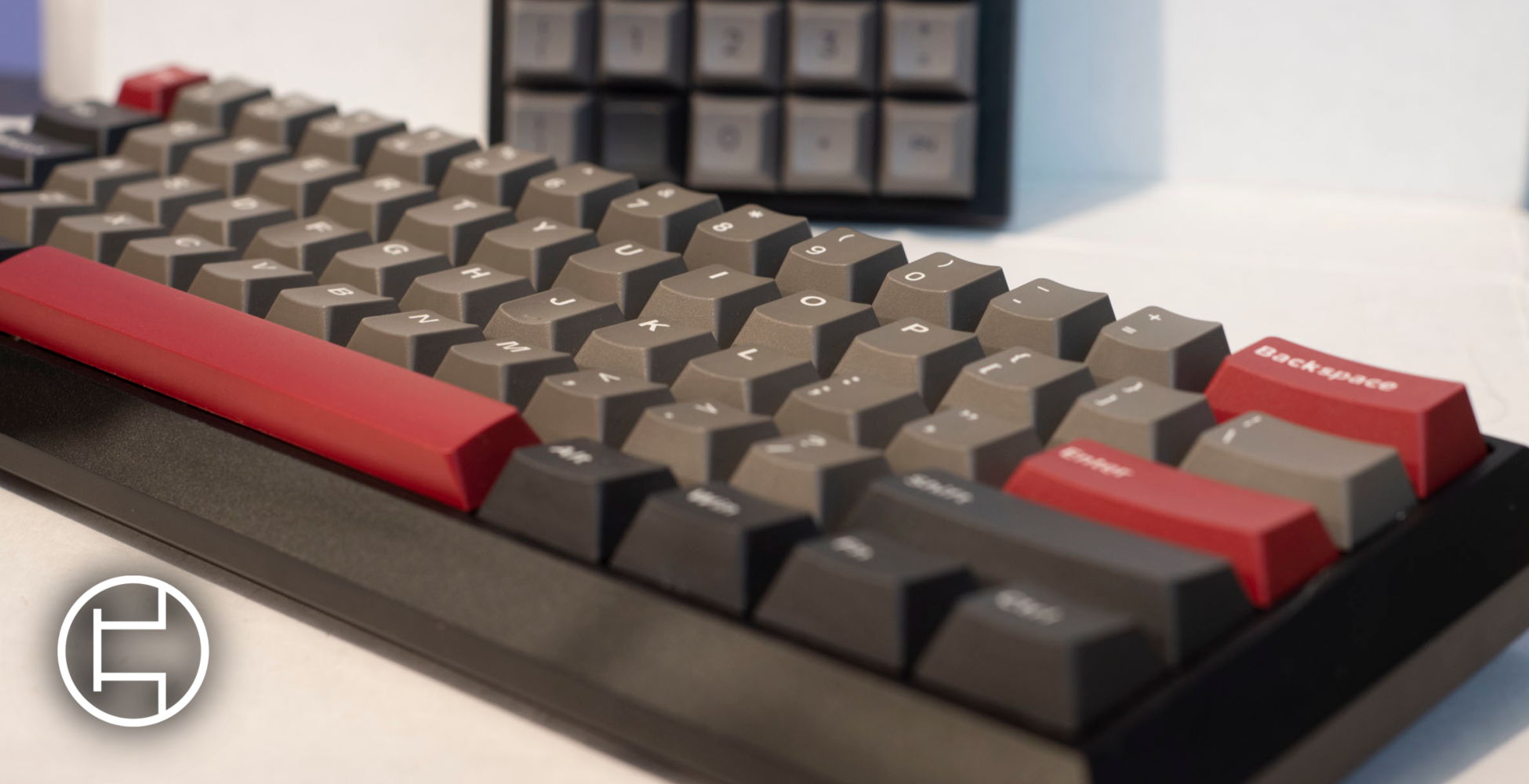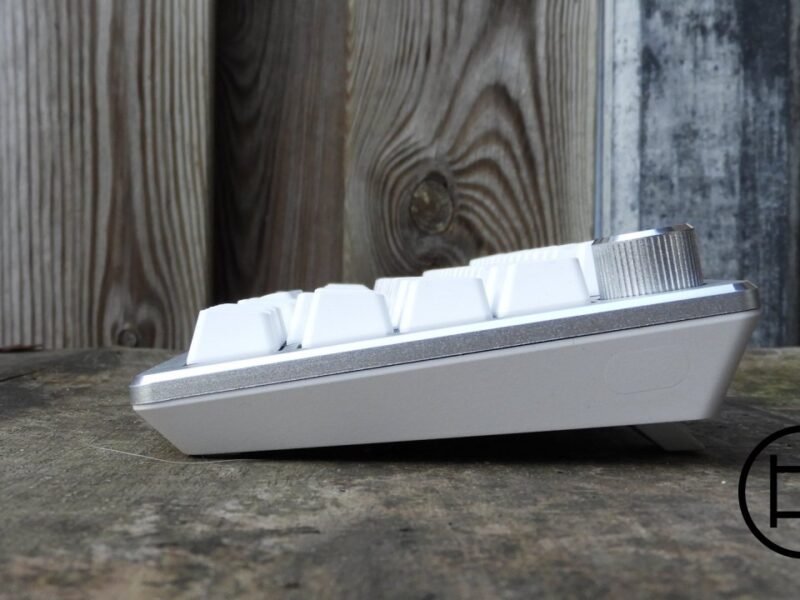This is Part 2 of a 5-part series on keyboards. Linked below are the rest.
Part 1: Switches
Part 2: Keycaps
Part 3: PCB and Stabilizers
Part 4: Case, Plate, and Mounting
Part 5: Buying Parts
Keycaps are the things you’ll be touching while you’re using your keyboard, so it’s a good idea to learn about them. While they do not affect the typing experience as much as the switches themselves, keycaps affect the sound profile to a noticeable degree. In this guide I’ll provide as much information as I can so you are able to make an informed decision about your keycaps.
Keycap Mounts
The most common mechanical keycap mount is MX, a reverse cross mount that fits on MX and MX compatible switches.

Another common mechanical keycap mount is Alps, which is a bar mount that fits on Alps switches and their clones, such as Matias switches.
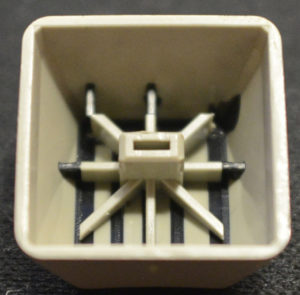
Keycap mounts for membrane keyboards tend to vary board by board, but a rare few use MX mount. The MSI Vigor GK30 is an example of this.
Keycap Profile
Keycap profile is the feature that makes the biggest difference in switch noise, right after the switches and case. In general, the taller the keycap the deeper the sound. For example, using SA profile keycaps results in deeper switch noise than Cherry profile keycaps, due to the extra space allowed for the noise to reverberate.
Here is a profile comparison between some of the most common keycap profiles from keycaps.info. Out of these, OEM and Cherry profile are the most common on prebuilt keyboards. If you click on the picture it’ll take you to their site, where you can get better comparisons.
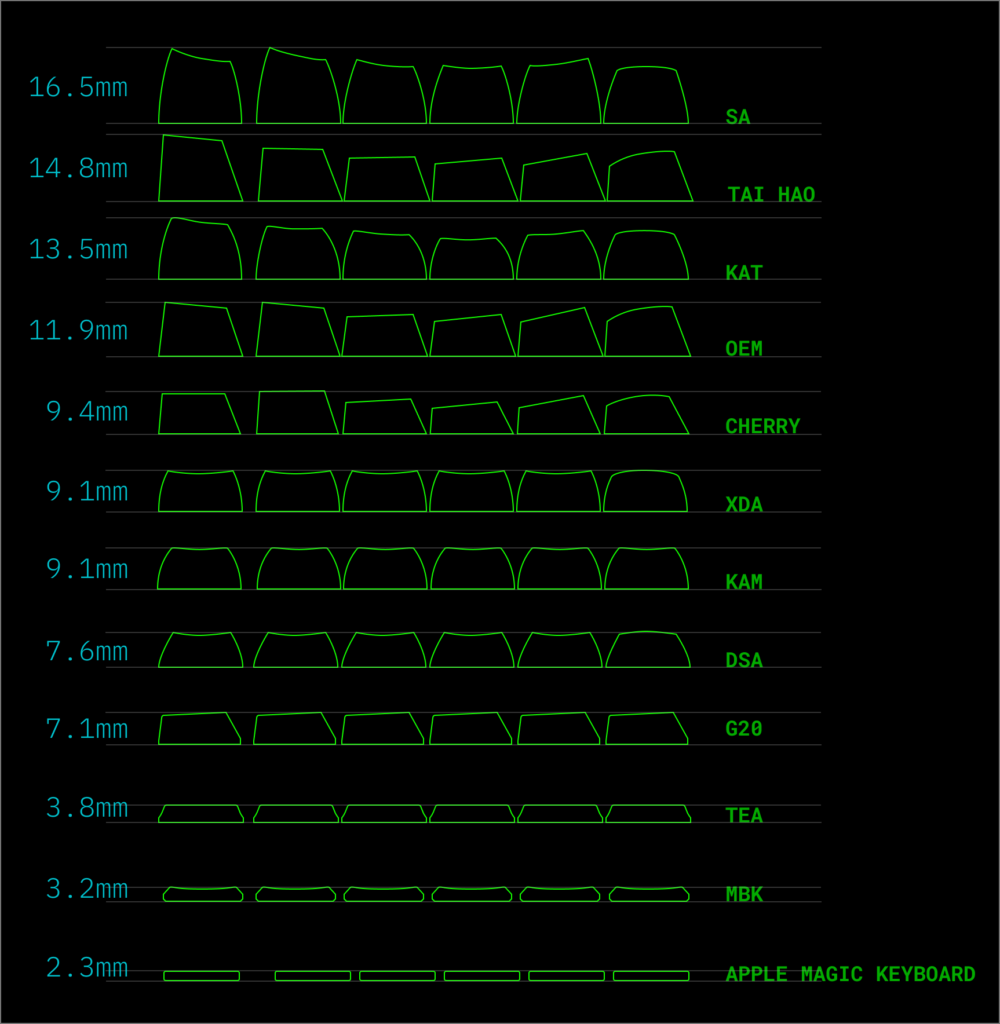
There are other profiles than the ones listed in the diagram above, but they are not widely used or manufactured.
Keycap Material
– ABS (Acrylonitrile Butadiene Styrene)
ABS plastic is the most common keycap material. Color reproduction on ABS is some of the highest quality you can get.
Because it is a “soft plastic”, ABS shines with use over time. It also yellows through exposure to UV rays. It is reversible by exposing the plastic to hydrogen peroxide, a bleaching agent, and a source of energy, but I will not recommend it.
– PBT (polybutylene terephthalate)
PBT plastic is less common than ABS in the keycap world, but it is still relatively easy to find. It has a higher melting point than ABS, allowing for die sublimation (see next section) to be done to a better degree. PBT is a harder plastic than ABS, and it takes much longer to shine.
PBT keycaps, especially spacebars, are more prone to warping than ABS thanks to the higher melting point. Color reproduction on PBT is not as good as ABS.
– Others
Other keycap materials include POM (polyoxymethylene), PC (polycarbonate), and PVC (polyvinyl chloride). POM and PC aren’t widely
used in consumer keyboards, but companies such as HP, Dell, and Logitech use PVC as an ABS alternative in some of their keyboards.
Keycap Legend Printing
– Doubleshot Injection
Doubleshot injection molding is the most durable type of legend printing. Two different colors of plastic are used to create a single keycap, which creates legends that cannot be worn off without physically damaging the keycaps. The most well known manufacturer of MX compatible doubleshot keycaps is GMK, who use the original Cherry molds to make keycaps.
Doubleshot keycaps are typically the most expensive out of the most common legend printing methods because they need stricter quality control than most other legends.

– Die Sublimation
Die sublimation is another very durable type of legend printing. Special die is injected into the plastic through heat and pressure, similarly to how an ink printer works. This means that the legends will not wear off through use without physically damaging the keycaps, similar to doubleshot lettering. Die sublimation is often done on PBT keycaps rather than ABS. PBT’s higher melting point means the printing can be done at higher temperatures, allowing for better results.
If the die sublimation tooling is worn out or not calibrated properly, the legends can print on the wrong part of the keycap. This is noticeable on the Unicomp Model M I reviewed. Over time the ink diffuses within the plastic, leading to blurry legends.
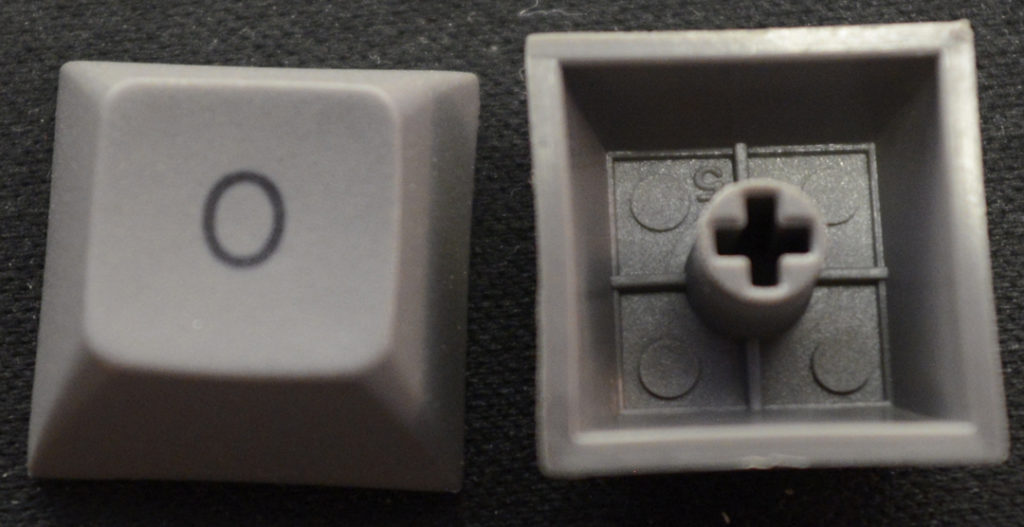
– Laser Ablation
Laser ablation is very common for “gaming” keyboards. It is done by coating a keycap, usually translucent ABS, with an opaque material. This material is etched through using lasers, leaving the legend as a gap in the opaque layer. This is one of the least durable types of legend printing, but it is one of the most widely used where backlighting is present.
– Others (Pad Printing, Infilling, Lasering, and Silk Screening)
These can be hard to tell apart from a glance, so I’m grouping them together. All four are common on a standard office keyboard.
Take a pad, put some ink on it, squish it on a keycap. Congratulations, you have a pad printed keycap legend.
Infilling is where you use a laser to etch a legend in a cap then fill it in with ink. Pretty easy to remember.
Lasering is where you etch the legend into the keycap, but it isn’t infilled. Matias uses this method for their keycaps, and Cherry used it on many of their boards.
Silk screening is done by putting a removable layer with cutouts for the legends on top of the keycaps before painting over the keycap or keycaps. This is easily the least durable printing method.
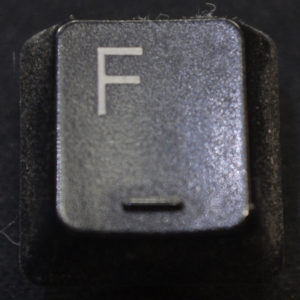
Keyboard Layouts
– ANSI
This is the most common layout in the US, as well as the easiest layout to find aftermarket keycaps in. The enter key is in line with the rest of the keycaps and slightly wider than the backspace key.
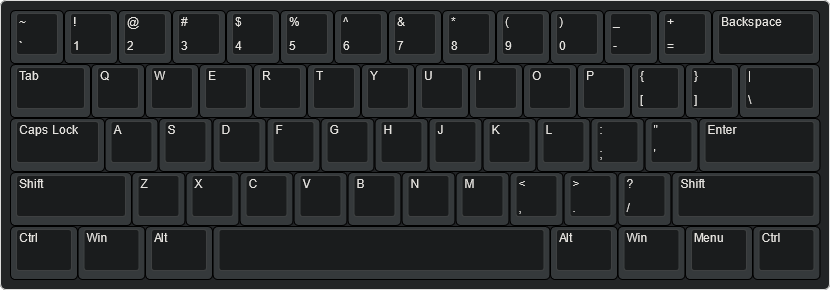
– ISO
This is the standard layout in Europe and some of Asia. The enter key is a funky tall shape and the left shift is split. Countries like Portugal and Germany have extra legends and different legend layouts, but the physical layout is the same. AltGr is used to access any tertiary legends.

– Asian Layouts
These layouts are widely used by manufacturers based in Asia. Asian 104 is widely used in Japan and by manufacturers like Chicony and Keytronic. The Monterey layout was used by Monterey and some early Focus-made keyboards, and the Focus layout was widely used by Focus before the introduction of Windows keys. The enter keys on these layouts are referred to as “bigass enter keys”.
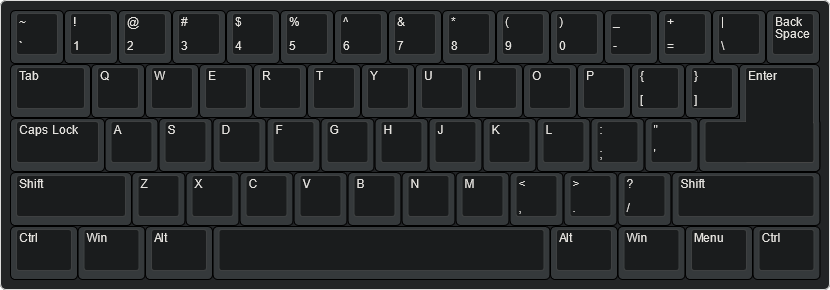

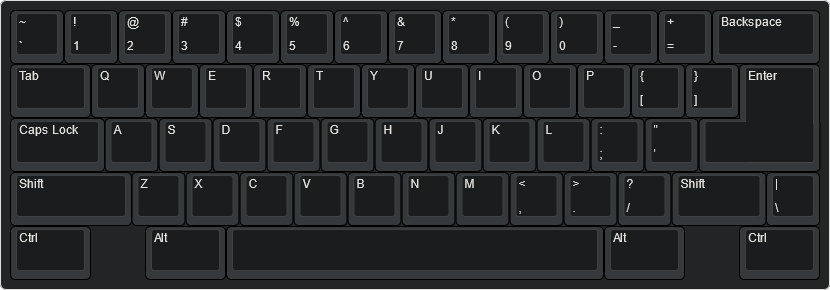 Top to Bottom:
Top to Bottom:
Asian 104, Monterey (Asian 102), Focus
Bottom Rows
Bottom rows are very important to pay attention to when buying keycaps for your keyboard. Some brands thought it was a great idea to change the size of some of the keycaps for whatever reason, and it affects compatibility. Corsair and Razer are the biggest culprits, but G.Skill has also been caught red handed.
The keycaps are measured in “units” (u), using a standard letter keycap as the base measurement.
– Standard
This bottom row layout is used on all standard keyboards. There are other bottom row layouts that can be considered standard, but the official standard for ANSI and ISO is as follows.

– Corsair
This bottom row layout is used on all of Corsair’s mechanical keyboards, and Cooler Master used this layout on a few of their older boards.

– Razer
This bottom row layout is used on Razer’s blackwidow lineup and Huntsman v1 elites.

– G.Skill
This bottom row layout is used on G.Skill’s KM780 lineup. There are no replacements for the spacebar as of May 2021.

– Logitech
Logitech uses this bottom row on all their mechanical keyboards I could find. There are no replacements for the spacebar as of May 2021.

Buying Keycaps
Keycap buying happens through one of two mediums: Group Buys and In Stock.
– Group Buy
Essentially a preorder without any stock afterwards, unless the vendor orders extras. You buy a keycap set with an estimated shipping date. If the group buy doesn’t reach the target amount for a set or piece of the set, the manufacturer will cancel it.
– In Stock
Your normal buying procedure. Find something you like, add it to cart, and it gets shipped to you when it’s ready. In stock products are usually continually stocked, so you can get them any time.
That’s about it! Any information past this point has diminishing returns, and I wanted to make this article readable while still containing as much information as I could fit.
Next up is Part 3: PCBs and Stabilizers
